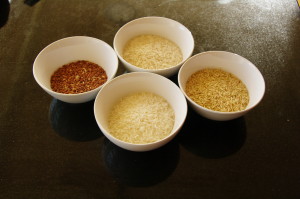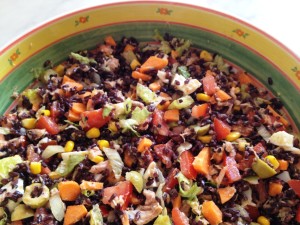Get To Know Your Rice Varieties
With more than 40,000 varieties worldwide, we thought we’d keep our sanity by narrowing the list down to those we most likely could find in a store.
To begin, let’s look at a few basic rice facts. Rice is a grain that grows in fields or paddies and has three edible parts; the bran, germ, and endosperm. Rice that has been milled and polished to remove the hull, bran, and germ is called white rice. Rice that has been hulled only, leaving the bran and germ intact is called brown rice. Brown rice and white rice are not actually species or varieties of rice, but are more accurately the result of a process.
Now that we have that straight, let’s take a look at what we would most likely find on a grocery shelf in America when we shop for rice.
Brown Rice
This rice is usually considered ‘whole grain’ rice, basically because the rice was not milled, leaving much of the bran and germ intact. Only the hull is removed. Brown rice is available in long grain, medium grain, and short grain. Long grain brown rice will remain somewhat separated when cooked, while medium and short grain brown rice kernels will tend to cling together more when cooked. All brown rice has a light, nutty flavor due to the remaining bran. Brown rice offers more fiber and the nutritional benefit of the bran and germ. You will need more cooking time for brown rice than white rice, but the delightful nutty flavor of brown rice may be worth the wait.
White Rice
This is another generic term used more to describe the rice than to name a variety. White rice is processed to remove the hull, bran, and germ, leaving just the internal endosperm, which is white. White rice can also be purchased in long grain, medium grain, or short grain, but all cook up a bit stickier than any length brown rice grain. Enriched white rice has been added to American shelves since a severe shortage in folic acid was found to be the cause of birth defects. Other nutrients have been added back into white rice, as well.
Arborio Rice
This rice is sometimes mistakenly called risotto in America. The grain gets its name from a town in Italy where it is grown. Arborio rice is used to cook the dish, risotto, which is a very creamy dish created by adding liquid to the rice, stirring, then adding more liquid and stirring some more until the liquid is absorbed and the rice is tender.
Jasmine Rice
If you cook any Asian dishes, you might know this rice. With a super sticky finish, this rice is perfect for dishes that need to hold up under a lot of ingredients. The texture is very popular in stir fry meals. The rice is also very fragrant.
Basmati Rice
This rice is from India. When cooked, it stays fluffy and separates. Although some may confuse it with Jasmine rice, they are not similar. This rice has an aroma, but it is not like Jasmine. Once you learn the difference, you will not confuse the two.
Converted Rice
This is a process which produces an ‘instant rice’ to some degree. The rice grain is steamed before milling, resulting in a shorter cooking time. This may be handy, but the nutrients are compromised during the processing. Any rice that has a reduced cooking time was processed to a great degree.
Of course, this just covers the basics of the rice varieties found on the grocery shelves in the United States. Since we know there are over 40,000 varieties worldwide, we know we are missing some important rice choices to enjoy. This simple primer should get you started, however, to find the best rice for your family’s personal tastes.
We are going to devote the month of march to Rice, with many great recipes and some fact finding articles. Hope you enjoy it! Here’s a cool recipe:
Italian Antipasto Rice Pot
- 1 1/2 cup water
- 1/2 cup tomato juice
- 1 cup uncooked rice
- 1 tsp dried basil
- 1 tsp dried oregano
- 1/2 tsp kosher salt
- 1 can (14 oz) artichoke hearts, drained and chopped
- 1 jar (7 oz) roasted red peppers, drained and chopped
- 1 can (2 oz) sliced ripe olives
- 2 tsp fresh chopped parsley
- 2 tsp fresh squeezed lemon juice
- 1/2 tsp black pepper
- 2 tsp grated Parmesan cheese
In a large saucepan, gently stir together the water, tomato juice, rice, basil, oregano, and salt. Put over medium-high heat, bring to a boil, then immediately turn heat down to low, cover pot, and simmer gently until rice is cooked – about 15 to 20 minutes depending on what rice you choose.
Remove pot from burner and add the artichokes, red peppers, olives, parsley, lemon juice, and black pepper. Cover pot and let sit for 3 or 4 minutes to let heat through. Sprinkle the Parmesan cheese over the top and serve immediately.
Will serve 6 as a side dish or 4 as a main dish.
You can add some thinly sliced hard salami if you wish to more closely resemble an antipasto platter.











